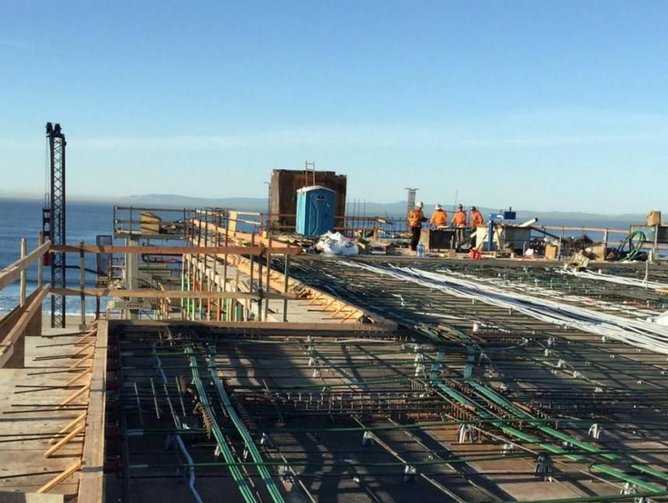As Group Manager at DavisReed, Derek Krider is overseeing a major expansion of the iconic Waterfront Beach Resort at Huntington Beach, California, and is doing so using the latest technology, bringing together talents of all ages and stages of development. Furthermore, the company is leveraging innovations in construction methods and supply chain management to deliver the project on time and on budget.
The Waterfront Beach Resort Project
DavisReed’s remit is to add 152 new hotel rooms to the existing 290 guestroom hotel, of which 106 will be suites. Furthermore, the whole complex will be renewed through a number of tasteful additions, including ballrooms, meeting spaces, pre-function areas, a new swimming pool, outdoor function lawns, new restaurants, a pool bar, and even a roof top lounge.
Additionally, the existing hotel is being renovated. This work includes revamping the lobby and Porte Cochere, adding a new spa, refurbishing back of house spaces, and reforming the restaurant and sundries store. A completely new bar and restaurant space will also be added, and the swimming pool and surrounding patios will also be completely renovated. The gross area for expansion will stand at 307,230 square feet with all phases of construction completed by the start of 2018.
“This is a GMP project where we have taken a collaborative, open-book approach with the owner,” Krider explains. “The on-site ownership team is extremely knowledgeable and construction savvy. Their expertise and understanding has contributed to a fully synergistic environment where efforts and energies are focused on problem resolution rather than traditional owner/contractor roles.
“This collaborative effort has been expanded to include the design team and we truly have a once in a lifetime team working together to construct a successful project.”
Skills for the job
Alongside his role as Group Manager, Krider is also Senior Project Manager. These dual responsibilities require him to assist with preparing the GMP budget, validating the construction schedule, assembling project teams and, ultimately, executing the work. Hiring the best personnel with adequate experience to execute a large project of this magnitude has been crucial.
“Frankly, after you ensure the skill and expertise is there, it’s all about chemistry,” he says. “Retaining personnel is always a challenge. I believe the only way you can retain them is by increasing employee engagement.”
“I subscribe to the philosophy that ‘you have to love them to lead them’. This requires that we step past traditional employer-employee relationship and take a personal interest in the employee’s wellbeing.”
The landscape in the construction sector is changing, and no more so than personnel management. For Krider, increasing millennial involvement (and the subsequent decrease in baby boomer participation) requires adaptation.
He says: “If you can invest in an employee in such a way that they feel like they are an integral part of value creation, then you increase employee engagement and increase the chance to retain this asset. This can be accomplished by allowing flex-time, working from home (when practical), mentoring on both a work and personal level, and simply showing a genuine interest in what is important to your employees.”
DavisReed encourages training for anything that will add value to the employee/employer relationship, Krider explains. This includes training for Primavera and Sure Trak scheduling software, as well as safety training covering first aid, OSHA 30-hour certification, and in-house “Lessons Learned” training.
Krider adds that, while the workplace is adapting to cater to the needs of a younger workforce, Millennials must take advantage of the opportunity to interface with some of the old-school builders who will soon be retired and out of the workforce. “If you can create an environment that bridges this multi-generational gap, everyone wins,” he says.
Continuous improvement
Krider recognizes that younger workers are on the pulse of the latest developments in technology and he is using this knowledge to drive organizational change. He says: “Being willing to listen to their suggestions and being open-minded to implement change, fosters an environment conducive to continuous improvement.
“From a generational perspective, the willingness for the Baby Boomers and Gen-Xers to be open to the technological advances that Millennials bring to the table is paramount. Simultaneously, Millennials learn traditional face to face communication methods.”
DavisReed has deployed a file sharing and collaboration platform (Box) that allows for real time updating and interface with project teams. This platform allows files to be updated and shared; information can also be shared between subcontractors, designers and owner’s personnel efficiently. “The program ensures everyone has access to the most current documents and can be accessed remotely by anyone that has been given access,” Krider says. “This allows for us to manage our supply chain more efficiently.
“We are using Level 300 BIM modelling for clash detection and MEP/Structural coordination. We are utilizing design-build methods with the auger pressure grouted piles, MEPF trades, steel stairs and aquatics. We also took on pile cap design under our scope.”
Leveraging the construction supply chain was something Krider and his team were keen to do at the very beginning of the project. “By being in a position to selectively pre-qualify subcontractors and vendors that can deliver the best product in the most effective manner,” Krider adds.
“Utilizing cloud-based technology for file sharing increases value by minimizing approval durations and release of procurement. Utilizing design-build methods with the major MEPF and aquatics trades allows for increased coordination and expedited procurement of long-lead materials.”
Overcoming challenges
“The footprint of the new expansion takes up the majority of the 3.5 acre site,” Krider explains – delivering the project in spite of local limitations is a key challenge for DavisReed, but the company is overcoming this.
“The west side of the project houses the existing 290 room guestroom tower; the south side of the site is bounded by the major 4 lane thoroughfare of Pacific Coast Highway. We have been able to utilize part of the public streets at the east and north for trailer parking, pedestrian traffic, product delivery and fire lane access.”
“The site is very tight and requires significant coordination with delivery and offloading of materials. Concrete placement and material deliveries require a well-orchestrated process where trucks are temporarily staged offsite until they are ready to be offloaded.
“One of the most noteworthy challenges is the work hours are limited to Monday through Friday, 8:00am until 6:00pm (5:00pm during winter months where daylight is limited). This constraint limits our ability to work overtime or make up for time lost due to weather and/or material delays.”
Having leveraged all the assets at its disposal, DavisReed is delivering the Waterfront Beach Resort project in line with its own high standards and with those of the owner. Combining both old and new knowledge from its workforce, and by taking advantage of technological and supply chain innovations, the company is on course to showcase the best of its abilities.




